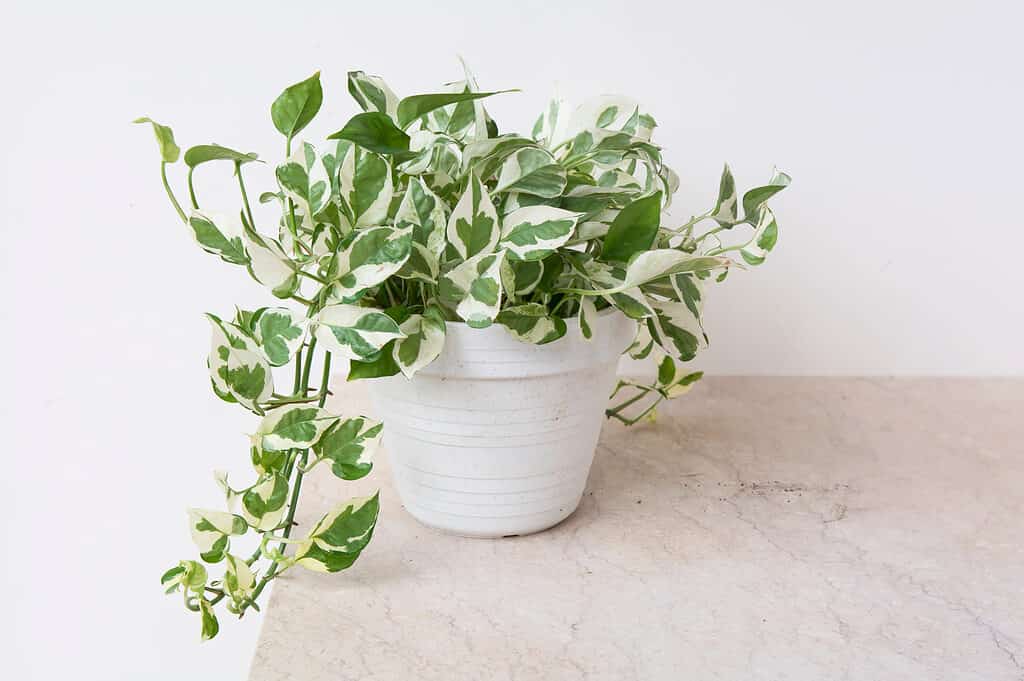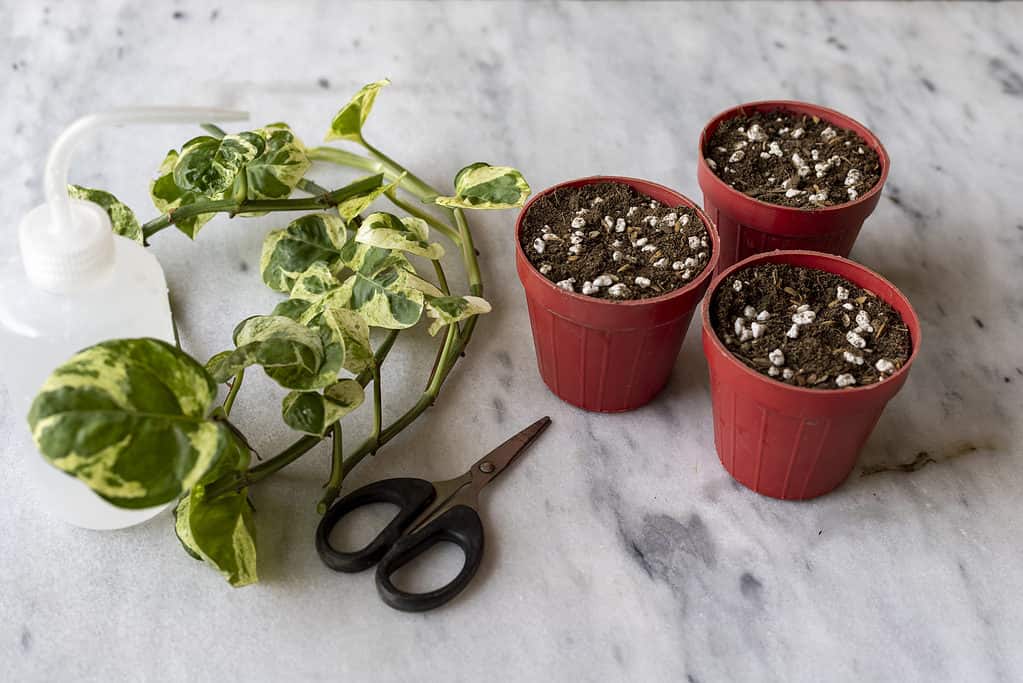The glacier pothos, a cultivator of the well-known marble queen pothos, is a delicate pothos variation with gorgeous green and white hues. It is sometimes mistaken for its two near cousins, the N’Joy pothos and the pearls and jade pothos, since to the untrained eye all three types resemble one another. The glacier pothos, in contrast to the N’Joy and pearls and jade pothos, has a more silvery-green hue which can be used to identify it online and in nurseries. The glacier pothos is said to be uncommon and harder to find, and its leaves tend to be more oval-shaped than those of these other two types.
The glacier pothos is regarded as being quite robust and low-maintenance, much like the majority of pothos. It thrives in the majority of typical home environments and can endure some neglect if necessary. Moreover, this adaptable plant looks fantastic hanging from a wall or shelf, planted in a pot on a table, or climbing upwards from a moss pole. But, you should be informed that this variety of pothos, like other pothos plants, is thought to be poisonous to pets and humans. Be mindful of where you place any type of pothos plant in your home!
Let’s take a look at everything you might need to know about the glacier pothos, from its care to common facts about this stunning variety.
Glacier Pothos Care Requirements
The glacier pothos is an attractive and easy-going plant that is ideal for both beginner and experienced plant parents. For the most part, the only things you need to keep this pothos cultivar happy are semi-regular watering and a sunny location. This variegated variety won’t pose a challenge for you if you’ve previously taken care of any other variety of pothos. Don’t be concerned if your plant isn’t erupting with new growth, though, since the glacier pothos is said to develop more slowly than some of its siblings in the pothos family.
Between waterings, allow the top two to three inches of soil to dry out, and then water the plant well. While this pothos cultivar appreciates routine watering, it is drought resistant and should be given a little time to dry out between waterings to avoid root rot. Every time you water, be sure to always let any extra water drain through the drainage holes in the pot. This will help prevent overwatering and root rot.
The glacier pothos can generally tolerate normal indoor humidity levels, but it will definitely flourish if given extra humidity. Because of the naturally humid environment in most bathrooms, this plant makes an excellent bathroom plant, granted that there is a window or light source in the bathroom itself. A small humidifier placed near the plant can also help.
Pothos thrive in temperatures between 65 and 75 degrees F since they are native to warm, humid climates. The glacier pothos is no different; they are hence ideal for growing indoors. Remember that glacier pothos are not frost-tolerant plants and should not be placed near any windows that are chilly or drafty in the winter to prevent shock.
A lot of bright light is appreciated by this pothos variety. Although this lovely variety of pothos can survive in low light, a position with a few hours of very bright and indirect light is the best option. This is not a pothos variety that thrives in low light, though many other varieties do. The glacier pothos, which has very variegated leaves, will grow leggy and start to lose its variegation if it does not get enough light.
Planting glacier pothos requires a soil mixture that drains effectively while still holding some moisture. This balance can be attained by combining organic and mineral components in a one-to-one ratio. We recommend a combination of organic potting soil and organic perlite. Although the majority of indoor potting soil has some perlite, adding additional perlite before planting your glacier pothos will guarantee that the soil doesn’t get too compact over time and will offer the roots enough drainage. Just as well, the glacier pothos benefits from routine fertilizing to ensure robust, healthy development during the growing season. For the best possible results, apply a balanced liquid fertilizer once per month during the spring and summer. When the plant is not actively growing in the fall and winter, stop fertilizer treatments to avoid harming your plant.
Glacier Pothos and N’Joy Pothos: Identifying Key Differences
The species Epipremnum aureum includes two unique and similar cultivars, the glacier pothos and the N’Joy pothos. While their care requirements are somewhat similar, their origins, outward looks, and development characteristics differ. Also, it is more difficult to find and buy glacier pothos.
The origins of these two exquisitely variegated pothos must first be considered in order to understand their distinctions. The Solomon Islands are the place where the tropical plant known as the glacier pothos first appeared. In contrast, horticulturists further developed and nurtured the N’Joy pothos for the general market from an odd stem mutation of the marble queen pothos. These two pothos varieties have remarkably similar juvenile appearances, but as they age, it gets a lot easier to distinguish between them.
Compared to other pothos plants, the leaves of the glacier and N’Joy pothos are relatively tiny. Also, rather than the traditional heart-shaped formations we find on the golden pothos, for instance, they are both more likely to resemble ivy. In contrast to the N’Joy’s rather erratic leaf growth, the glacier pothos has somewhat smaller, rounder leaves that are more evenly distributed in size.
The glacier pothos has white, silver, and light green variegation patterns that give it the appearance of a marble queen. Its hues are often paler than those of the N’Joy, with greater patches of streaky, patchy variegation that generally follow the outline of each leaf from the center outward. The velvety, silky feel of the glacier pothos’ leaves is one of the reasons it is sometimes called a delicate plant. The leaves of the N’Joy pothos are waxier and have a leathery underside.

The N’Joy pothos (pictured) has a notably similar appearance to the glacier pothos, but it differs in leaf texture.
©Christina Siow/Shutterstock.com
Growing Glacier Pothos Outdoors
It is highly recommended to grow glacier pothos plants indoors where temperature and humidity can be better controlled. However, if you live in USDA hardiness zones 10 or 11, you might be able to grow your pothos outside. Look up your location to ensure you do not live in an area where pothos cannot be grown outside, as they are sometimes an invasive species.
Repotting Glacier Pothos
When you notice white roots growing around the sides of the soil or snaking through the drainage holes, it’s time to repot your glacier pothos. Before it gets to this point, try to increase the size of your pot. Repotting should usually be done after the plant has doubled in size. Select a pot that is about two inches wider in diameter than the old one; larger pots might cause waterlogging and root rot due to the additional soil.
Pruning Glacier Pothos
The glacier pothos does not require pruning, however, it can be done every once in a while to manage its development. Remember that since this pothos grows slowly, any growth that is removed won’t come back right after pruning. It’s also crucial to be aware that pothos do not branch out at the site of a pruning cut, in contrast to several other species of houseplants. A trimmed pothos vine often sends out a new shoot from the nearest node and keeps growing the single vine in this manner. There can occasionally be more than one new growth point, although this isn’t usually the case.
To prune your glacier pothos, use sanitized scissors and try to cut near the nodes. Don’t overdo it, though. As we mentioned earlier, this is a slow-growing plant!

Pothos propagation (pictured) is quite simple and easy to do.
©iStock.com/Bilal photos
How to Propagate Glacier Pothos
The glacier pothos can be propagated via stem cuttings, just as any other pothos would. By transplanting the rooted cuttings in the same pot, you can grow your pothos to a larger and fuller size. You can also grow additional plants to keep or give to others by propagating your pothos.
Propagating pothos plants is a very easy process. Use a pair of pruning shears or scissors to clip stems from a healthy mature glacier pothos plant. There should be at least three to four nodes on the stem of each stem cutting, but no more than six or seven. Cuttings will have a harder time rooting if they are excessively long or have an excessive number of nodes or leaves.
Each cutting should have its bottom two leaves removed to reveal the nodes at the stem’s base.
Prepare a container with fresh water, then immerse the exposed stem portion of the stem cuttings while leaving the cutting’s top leaves above the water. The cuttings should be placed in an area that receives bright and indirect light, and the water should be changed once each week with dechlorinated, purified water. You should start to see little white roots emerging from the stem’s nodes after a few weeks. Cuttings can be placed in soil once the roots are at least an inch long.
The propagated cuttings, once rooted, must then be gently planted into soil that drains well. You will need to eventually replant the now-rooted cuttings in their original, well-lit position after giving them a thorough watering and allowing any extra water to drain from the container. To aid the cuttings in readjusting to the soil during the first several weeks, you should maintain a uniform moisture level in the soil. You can resume leaving the soil slightly dry between waterings after one to two weeks. From then on, simply care for your new pothos plants the way you would care for the parent plant.
Pothos Pests to Watch Out For
While the glacier pothos is not particularly susceptible to any specific pests or illnesses, you should be on the lookout for several typical houseplant pests that will gladly make this plant their home. Keep an eye out for symptoms of mealybugs, scale, and mites. In order to avoid full-blown infestations, it is a good idea to routinely examine your houseplants for symptoms of pests. Often, these bugs will infest a new pothos by migrating from another afflicted houseplant. These pests can be killed off with neem oil or an organic pesticide treatment.
The glacier pothos is a very endearing little plant that looks lovely in any home or office. As long as you follow its minimal care requirements, you’ll be able to enjoy this beautiful variegated pothos variety for many years.
Up Next:
- Pothos Light Needs: How Much Sunlight Do Pothos Need?
- Discover 3 Pothos Varieties
- Are Pothos Good Plants for Apartment Living?
The photo featured at the top of this post is © Willowtreehouse/Shutterstock.com
Thank you for reading! Have some feedback for us? Contact the AZ Animals editorial team.







